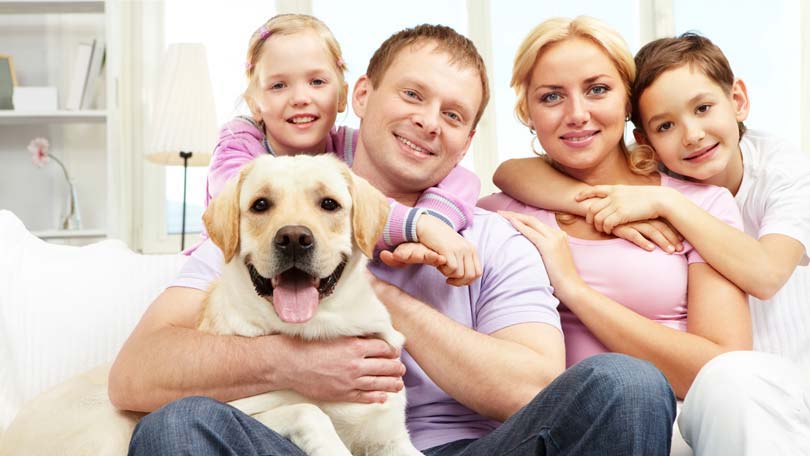
We finally moved into the new home we had built and boy, were we happy! With all of our earthly belongings hauled inside, it was time to show the place to the pets.
Tinkerbell (Saint Bernard), Cutie Pie and Buddy (Pekingese), and Jingle Bells (Maine Coon) were escorted in and presented with the house. They were not as impressed as we had hoped. In fact they looked to us as if they’d missed something, but were perfectly happy to be with us once again. Oh well.
That evening, with much left to be unpacked and my wife and daughter in their beds, I made one last check of the windows and doors before going to sleep. Three dogs and a cat looked to me expectantly.
I realized they probably were not thrilled about sleeping on the tile floors, so I found towels to cushion their slumber until their beds were found. I made sure they had bowls full of food and water, noticing they seemed misplaced and liable to be tripped over there in the kitchen. The cat had nothing to climb. It occurred to me:
Shouldn’t all homes be built with pets in mind?
Over fifty percent of homes in the US have pets and that number is growing. Only a slightly smaller number own multiple pets. Americans spend more than 36 billion dollars every year on their canine and feline family members, and very often a design concept is pet, human, and environmentally friendly all at once.
Pets are one of the fastest growing positive factors in human households and possibly our best method of home protection as well.
I thought of a famous quote:
“The greatness of a nation and its moral progress can be judged by the way in which its animals are treated.” – Gandhi
Would pet-friendly homes in the US and Canada be moral progress?
The new environment of our new home suddenly seemed unnatural for my pets. I realized home builders generally ignore the fact that there will likely be pets involved, other than an occasional fence, which may have other purposes like security anyway. I thought about what a pet-friendly design for a dog or cat might consider:
Overall
- Resilience
- Ease of cleaning
- Economic friendliness
- Style and comfort
- Affordability
- Customization
- Family and pet-conscious design
- Environmental friendliness
Interior; for comfort, versatility, and durability
- Allergen/odor reducing air filtration
- Durable, eco-friendly flooring
- Pet friendly fabrics and furnishings
- Easy clean surfaces
- Pet friendly mudroom
- Cat friendly windowsills
- Professional series central vacuum
Exterior
- Easy lawn care and landscaping
- Pet containment / fencing
- Pet exterior access doors
- Energy efficient windows and siding
- Low VOC paint (volatile organic compounds, solvents that get released into the air and cause headaches and dizziness)
There were interesting, perhaps even exciting ideas here that would not be hard to implement. But why?
What positive impact could come from a more general acceptance of pet-friendly homes?
Well with less hassles involved in pet ownership the quality of life for pets and their owners rise, and there would be fewer spilling over into shelters of pets that became unmanageable. The movement would at once educate people about joys of pet ownership and simplify owning pets at the same time.
I was inspired. With all the known positive effects of pet ownership I felt I was on to a perhaps new and worthy cause, for both man and animal.
My pet-friendly home would have:
- Dedicated spaces for my pets, perhaps a pet room?
- Their own furnishings, whether built in or added, and incorporated into the design
- Dog couch/beds
- Cat tree/scratching/shelves
- Flooring that is resistant to fleas, dirt and smells
- A central vacuum system for easy hair removal
- Space fitted for/accommodating grooming
- Permanent location for food dispensing
- Dedicated food storage
- Fenced or otherwise contained yard
- Ingress/egress doorways
- Dedicated space for bathing
- A mud room buffer between interior and outdoor play areas
- Easy access for a dog bathroom and cat box
- Great air filtration
Also while I’m at it let’s add
- Green building materials
- Solar electric and hot water
- Efficient insulation
- An electric charging stations for automobiles
- Water purification
- Trash disposal systems that lessen environmental impact and encourage recycling
Some places are already hip to this. Many condominium and townhome developments and redevelopments of the earlier 2000’s included dog-walk paths with doody-bag dispensers and an off-leash fenced area for dogs alongside the tennis or volleyball.
For a veterinarian-owned hotel in Desert Hot Springs, California, pet-friendly means her hotel not only allows dogs but encourages them, provides dogs with freedom to roam (including the pool and breakfast area), and doesn’t relegate guests with pets to only certain rooms are areas.
But it seems all the homes I’ve lived in ignored the fact that the occupants were likely to own pets. Any pet-friendly modifications have always been made by me. Just as homeowners are likely to need a dining area, they are more and more likely to own pets. There could at least be some design elements that make later modifications easier.
I have more than once been stumped by wanting a dog-door in a certain place, only to be thwarted by the presence of a concrete wall. Builders could leave a channel if not an actual pet door.
My musings now sought company! This was too good an idea to sit on, and probably a concept that will emerge alongside the growing number of households with pets and the astronomical amounts already being spent on pets. It seems the only thing missing now is your voice added to the conversation, for ideas and support! Chime in!

